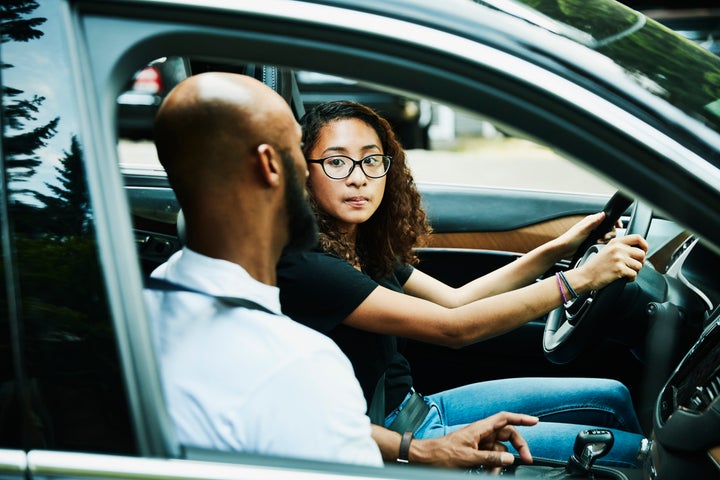
Worrying is part of the job when it comes to parenting. How else would we remember to adjust the car seat straps, apply sunscreen or cut grapes in half? Often, we’re worrying both for ourselves and on behalf of our kids, who are off exploring their world, feeling invincible in a way that only kids can. As they grow and learn new skills, like how to ride a bike or drive a car, we want them to temper that confidence with a bit of worry on their part, too. Enough to grant them a healthy dose of caution.
The prevailing image of teenage drivers is that they are more fearless than cautious. But, increasingly, teens are feeling anxious about driving. They also don’t seem to feel the pull of the road as much as in generations past and are putting off learning to drive and getting their licenses. The pandemic, which kept a lot of us off the roads, seems to have only heightened this trend.
Rosalind Thompson is a senior public affairs specialist at AAA Northeast who frequently works with young drivers.
“I am finding now more and more that teens are not as excited about getting a driver’s license. They are delaying the process — including my own son, who did not get a driver’s license until his second year of college,” Thompson told HuffPost.
Perhaps today’s teens are more aware of the dangers of driving, especially if car crashes have impacted people they know. Or maybe they feel less urgent about getting out of the house because so much of their life and socializing takes place online. Rideshare apps have also made it easier for teens to get around without a license themselves.
Anxiety plays a factor in teens’ hesitance, according to their parents. In a recent survey from Aceable, a company offering online driving and real estate courses, 73% of California parents reported that their teens were experiencing driving anxiety. Fifty-four percent said the anxiety was intense enough to be called a phobia. (The word for fear of driving is amaxophobia, from the Greek word for carriage.)
Parents reported that their teens lacked confidence in the following areas: parallel parking, highway/freeway driving, night driving and driving on mountainous or curved roads.
Some of these concerns can be location-specific. Laura Adams, the senior driving analyst at Aceable, told HuffPost, “We did see a lot of Los Angeles numbers that showed more anxiety related to traffic.”
Whatever the exact confluence of factors that have resulted in this trend, it’s keeping kids off the roads. The survey found that 42% of teens have delayed getting their license, 36% drive only when “absolutely necessary,” and 28% have skipped social events and/or extracurricular activities to avoid driving.
If your teen is experiencing anxiety around driving or seems hesitant, here are some things to keep in mind.

Don’t Push
Thompson thinks there is nothing to gain by pushing a teen who simply isn’t ready and advises parents to have patience.
“I did not push my son to get his driver’s license. He passed the written test. He was congratulated. And when I sat down and had a talk with him about what the next steps were going to be for him, he asked me to be patient and to wait. And I heard him,” she said. He did become a licensed driver on his own time.
Teens will likely find a way to work through their anxiety when they feel the need. The Aceable survey found that teens’ top motivations for driving were to get to a job (60%), hang out with friends (48%) and get to school (44%).
Start Slow
Graduated license requirements, which vary from state to state, can help ensure that your teen has a safe, easy beginning to their driving experience. In New York, for example, the junior permit that teens are eligible for at 16 requires them to have an adult in the car while driving. After six months, they can apply for a junior license that allows them to drive during daylight hours and with a limit on the number of passengers. Then, at 18, they can apply for a regular license.
These restrictions have been put in place to keep teens safe. New York reports an 80% decrease in crashes since graduated licensing was implemented. “The first 18 months are the most dangerous,” Thompson explained. It’s the period when a driver is most likely to crash.
New drivers’ first solo trips should be brief, familiar routes that they drive in the daylight, without passengers. “They should have no distractions. No phones, no interruptions, no music, they should be totally focused on driving,” said Thompson.
Set An Example
Understand that your child’s driver’s education begins years before they ever get behind the wheel. What kind of example are you setting? You have to model the driving behavior you would like to see one day in your child.
Adams says this entails “wearing your seatbelt, never using your phone, not eating or being distracted behind the wheel.”
“Your kids are watching you,” she added.
Michael Southam-Gerow is a professor of psychology at Virginia Commonwealth University and the author of “Exposure Therapy With Children And Adolescents.” He told HuffPost that parents should “remain calm while the teen is driving and model calmness when driving” as one way to help prevent or reduce the teen’s anxiety. He also recommends using a “talk-aloud” approach, which involves “narrating what you are doing and how you are thinking.”
You might say, while pulling out of the driveway: “My seatbelt’s on. I’m adjusting my mirrors. I’m looking behind me to the left and the right. I’m moving into reverse, and now I’m stepping on the gas.”
Be Encouraging, And Praise Success

When you’re starting out, if you’re going to be in the car with them, try to be patient and encouraging. You can practice with them in empty parking lots, to begin with, moving on to quiet, residential streets.
It can be hard to notice anything other than potential dangers, but it’s helpful, Southam-Gerow says, to “make positive statements about the teen’s driving.” They won’t do everything right the first time, but you can recognize every time they do something correctly.
Thompson encourages teens to have a checklist that they go through before turning on the car: putting on their seatbelts, adjusting the mirrors and planning their route. Because their phones should be out of sight (on airplane mode or with notifications turned off), they won’t be able to look up directions without pulling over and parking.
When they do return on time, car keys in hand, don’t forget to congratulate them for a job well done and commend them for their responsibility. Your praise still has an impact, even when teens don’t seem to react to it.
When To Seek Help For Amaxophobia
Driving anxiety is relatively common in adults and teens, and it can be hard to know when to reach out to a mental health provider. “A good rule of thumb is that if the symptoms of anxiety are impairing functioning in one of three areas (a) family, (b) friends, or (c) school/work, it may be worth consulting a mental health professional.”
Phobias are usually treated with a kind of cognitive behavioral therapy called exposure response therapy. It involves facing the fear for, at first, very brief stretches of time followed by increasingly longer ones.
“A key to exposure is repeated exposures — that is, lots of practice. Anxiety reduces over time as the teen learns that the predicted feared outcomes do not occur. That learning requires multiple repetitions of the same tasks. As an example, driving from the home to the school. Repeating that once may reduce anxiety a little. Doing it 10 times will reduce it much more,” said Southam-Gerow.
But even if your child doesn’t have a full-blown phobia, you can use the same principle to help reduce their driving anxiety.
Southam-Gerow encourages parents to “start low and go slow. That is, start with something small, practice that multiple times, and then move to something a little harder. And so on.”
Just as you were patient — usually — when your toddler was learning the norms of human behavior, you can lean on that same patience as they learn to navigate the road.
Stay Watchful Of Overeager Drivers, Too
It’s great if your kid doesn’t have a driving phobia, but you don’t want them to be overexcited about getting behind the wheel — those teens will almost certainly end up speeding.
“Be mindful if you have a team that is overexcited about driving, and get in the car [with them],” Thompson advised.
“Don’t be quick to hand them the keys,” she said. While a nervous driver is fearful of what the car can do, an overeager driver may not understand that the dangers of a vehicle are real.
You’re the expert on your kid. Some kids may want to drive, but if you think they need to wait and mature another year before getting their permit, then you should enforce that.
Find A Driver’s Education Program For Support
Some parents are successful in teaching their kids to drive, while others need the support of a different adult in the car with them. Many states require driver’s education, but even if you’re in a state that doesn’t require it, you can use this resource. Don’t be afraid to reach out for help when you need it or think it reflects poorly on your parenting.
“If the first two times of a parent going with their new driver the parent senses that the there’s stress and there’s tension ... the parents should pull away and suggest or start inquiring about driver schools,” Thompson suggested, adding that she did that with her son.
“I kind of doubled up on what I believe he needed just to make sure that I was covering my bases,” she said.